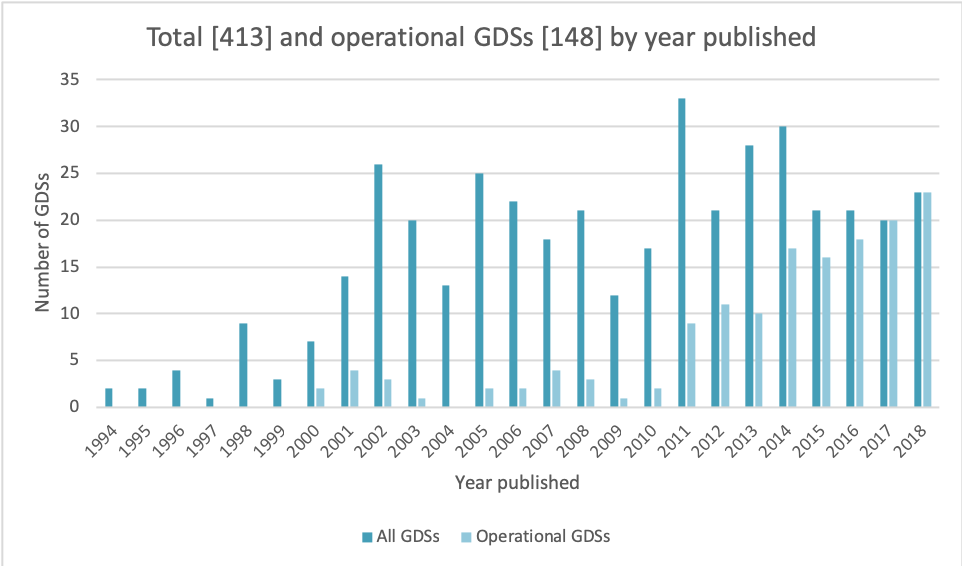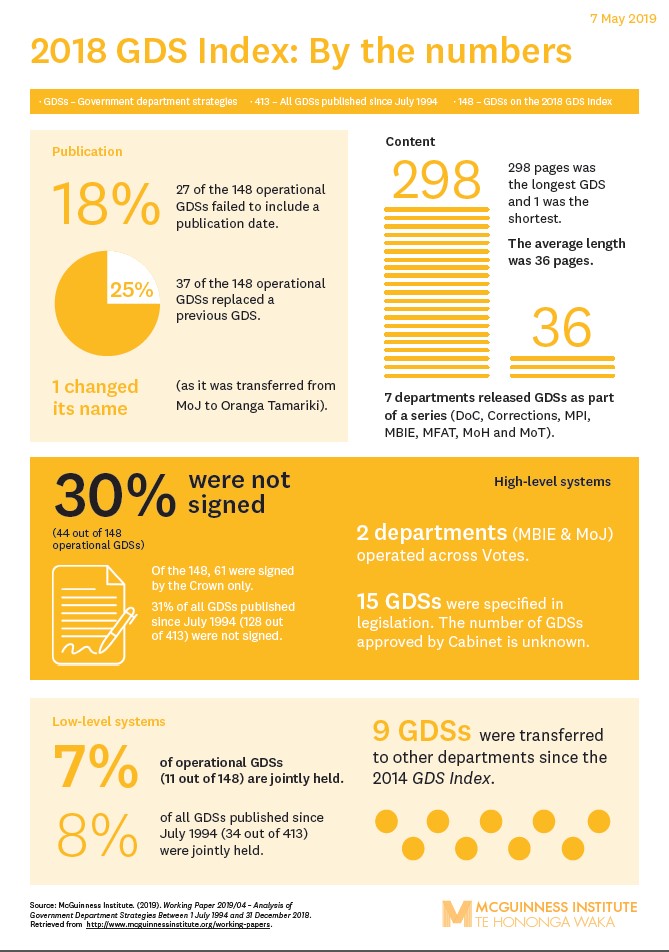The McGuinness Institute launched the 2018 GDS Index on Thursday 2 May 2019 at a lunchtime presentation attended by around 40 MPs, government department officials, and other interested parties. Wendy McGuinness discussed why government department strategies (GDSs) are important corporate documents, the process the Institute took in conducting the research, the obstacles and challenges experienced in conducting this research, and key insights (see Wendy’s slideshow below). A total of 148 GDSs were found to be in operation at 31 December 2018. The Institute has identified a total of 413 GDSs published since July 1994.

In addition to the working papers, which explore the data gleaned from the extensive process of collecting, identifying, scoring, ranking and analysing all government department strategies (GDSs), the 2018 GDS Index also saw the first time the Institute also published the Government Department Strategies Handbook – He Puna Rautaki, which collates key data on the GDSs on the 2018 GDS Index, their rankings and radar charts.

Wendy explains some of the challenges the 2018 GDS Index poses for the future.
The 2018 GDS Index research found that 148 GDSs were in operation at 31 December 2018. The rankings evaluate whether or not essential information is provided in the GDS documents, based on the Scorecard the Institute developed with the help of strategy experts. Ideally this is so that readers can go on and assess the quality of the strategic approach for themselves.
The top ranked GDS in the 2018 GDS Index is the Ministry for Primary Industries’ (MPI) Biosecurity Science Strategy for New Zealand – Mahere Rautaki Putaiao Whakamaru, with the top ten as follows:
1 Biosecurity Science Strategy for New Zealand – Mahere Rautaki Putaiao Whakamaru (Ministry for Primary Industries)
(Note: This GDS was ranked fourth in the 2015 GDS Index)
2 Rising to the Challenge – The Mental Health and Addiction Service Development Plan (Ministry of Health)
3 Tau Mai Te Reo – The Māori Language in Education Strategy (Ministry of Education)
4= Safer Journeys: Road Safety Strategy 2010–2020 (Ministry of Transport)
4= Ka Hikitia – Accelerating Success: The Māori Education Strategy (Ministry of Education)
6 Strategy to 2040 – He Kai Kei Aku Ringa (Ministry of Business, Innovation, and Employment)
7 Cultural Sector Strategic Framework (Ministry of Culture and Heritage)
8 Faiva Ora 2016–2021 – National Pasifika Disability Plan (Ministry of Health)
9 Nation of Curious Minds – He Whenua Hihiri I Te Mahara: A National Strategic Plan for Science In Society (jointly held between Ministry of Education and Ministry of Business, Innovation, and Employment) (Ministry of Education)
10 National Statement of Science Investment (Ministry of Business, Innovation, and Employment)
See the infographic below for more key facts and figures.
Further resources and reading
Working Papers can be accessed here.
The Handbook can be purchased here.
Frequently asked questions about the GDS Index project and the 2018 update can be seen below.
Q1: What’s new in the 2018 GDS Index?
In addition to updating the GDS Index working paper, in 2019 the Institute also published the Government Department Strategies Handbook – He Puna Rautaki (right) for the first time. At the launch Wendy McGuinness discussed why government department strategies (GDSs) are important corporate documents, the process the Institute took in conducting the research, and the obstacles and challenges experienced in conducting this research. This work is intended to contribute to a broader discussion about how to build strategic capability in the public service.
Q2: What was the highest-scoring GDS in the 2018 GDS Index?
The highest-scoring GDS on the 2018 GDS Index is A Biosecurity Science Strategy for New Zealand (October, 2007), published by MPI. The Institute found 148 GDSs in operation as at 31 December 2018 and scored each of these against the Scorecard.
Q3: How are GDSs scored?
The GDS Index ranks each GDS in operation by its document’s content of essential information. The GDS Index does not rate the strategy, it rates the extent to which essential information is provided in the strategy document so readers can go on and assess the quality of the strategic approach for themselves. Each GDS is reviewed against the Scorecard (see left) to determine how well it articulates each of the six elements. These are:
- Opportunities and Threats (what is the external environment?)
- Capabilities and Resources (what are the internal strengths and weaknesses?)
- Vision and Benefits (what is the purpose?)
- Approach and Focus (what choices and trade-offs have been made?)
- Implementation and Accountability (who is responsible for what?) and
- Alignment and Authority (how does the strategy align with the machinery of government?
Q4: Why does the Institute undertake GDS Index research?
The GDS Index aims to illustrate how New Zealand might strengthen GDSs to make them more effective, responsive, measurable, comparable and durable through public consultation, engagement and ownership. The assumption is that if government departments work hard to make the content of GDSs more useful, users of these strategies will be better able to assess their quality and, where appropriate, work with government to deliver better outcomes more quickly.
Q5: Where can I find the working papers and other 2018 GDS Index publications?
The 2018 GDS Index publications include the following:
- Government Department Strategies Handbook – He Puna Rautaki (May, 2019)
- Working Paper 2019/01 – Methodology for the Government Department Strategies Index New Zealand (May, 2019)
- Working Paper 2019/02 – Lists of Government Department Strategies Between 1 July 1994 and 31 December 2018 (May, 2019)
- Working Paper 2019/03 – Scoring Tables Collating and Ranking Government Department Strategies in Operation as at 31 December 2018 (May, 2019)
- Working Paper 2019/04 – Analysis of Government Department Strategies Between 1 July 1994 and 31 December 2018 (May, 2019)
Q6: When was the GDS Index last updated?
In 2015. The Institute regularly updates the GDS Index so that information can be measured, analysed and tracked over time. See Working Papers to view and download the publications that constitute the 2014 GDS Index and the 2015 GDS Index.
A total of 413 GDSs have appeared on the GDS Index. Of these, 265 have been archived. The remaining 148 GDSs are operational and can be viewed on the GDS Index homepage.

